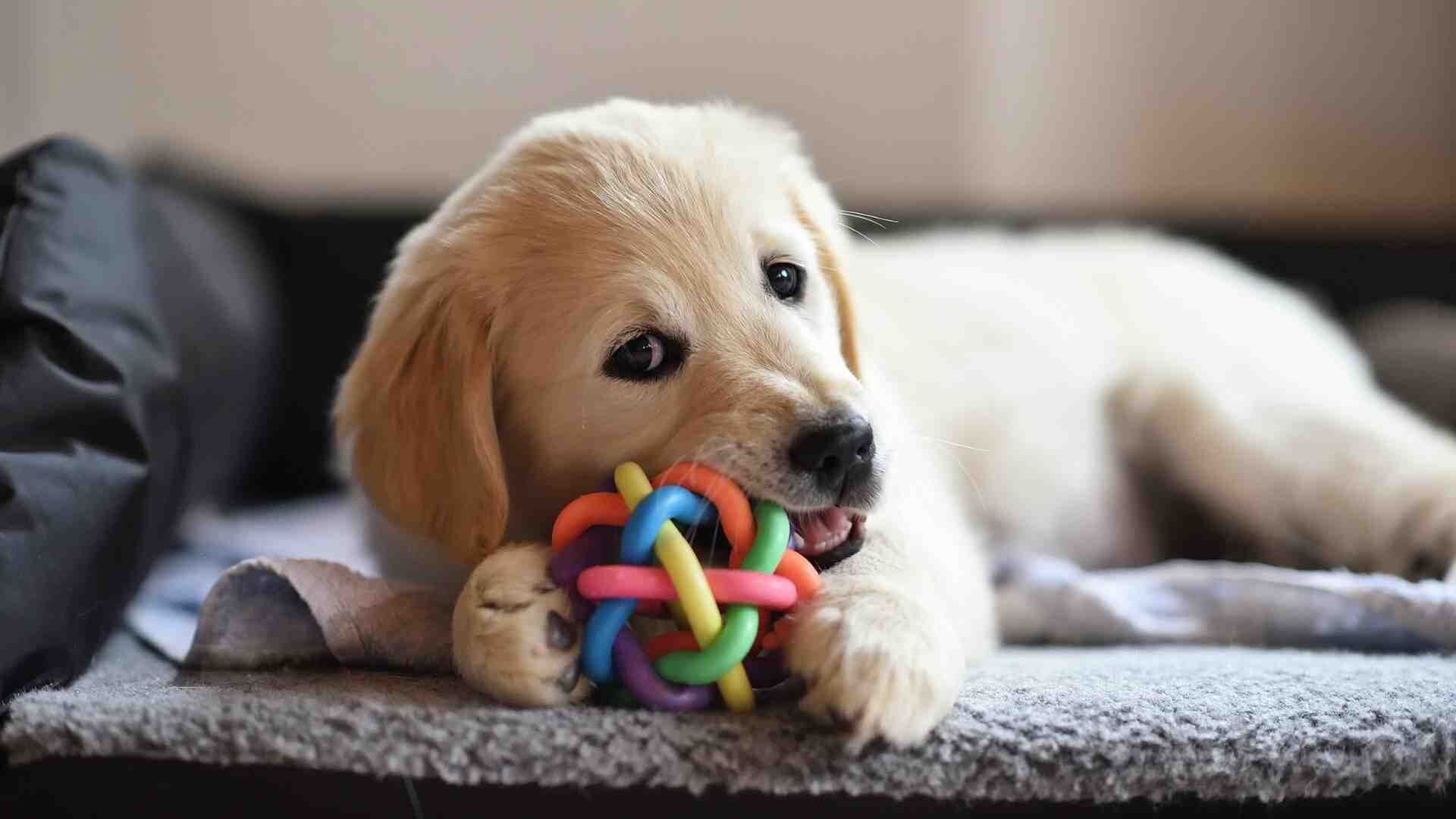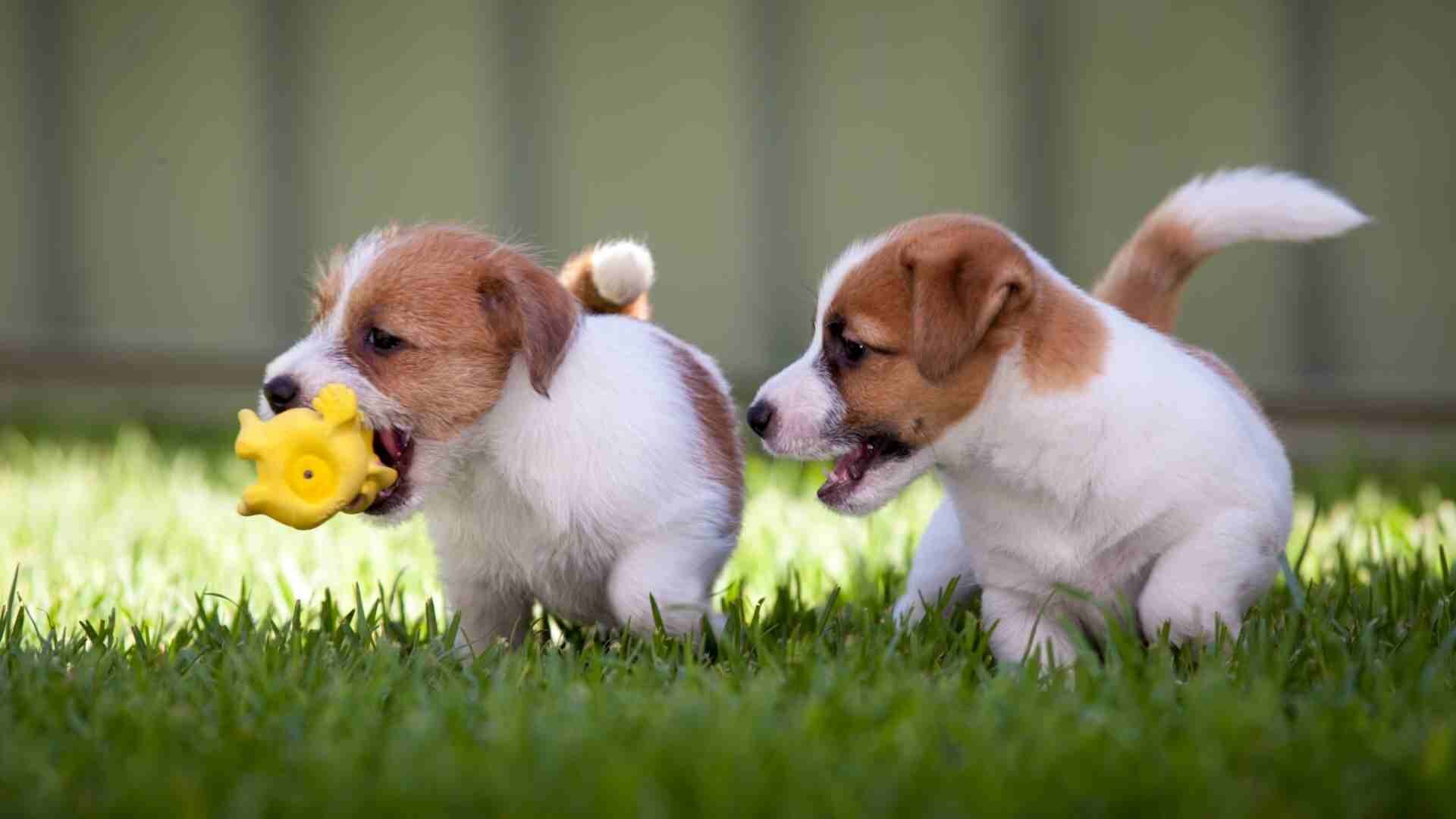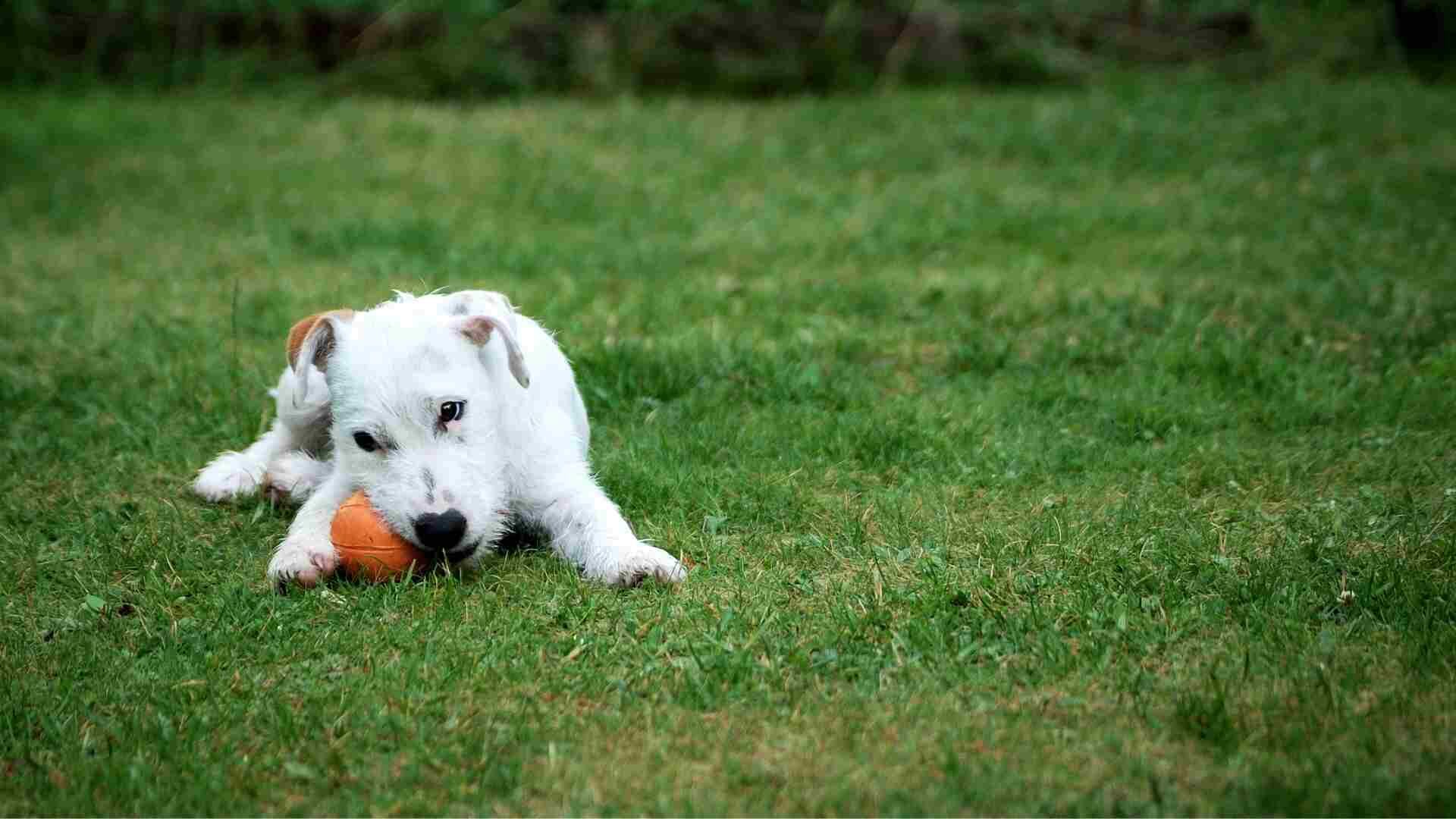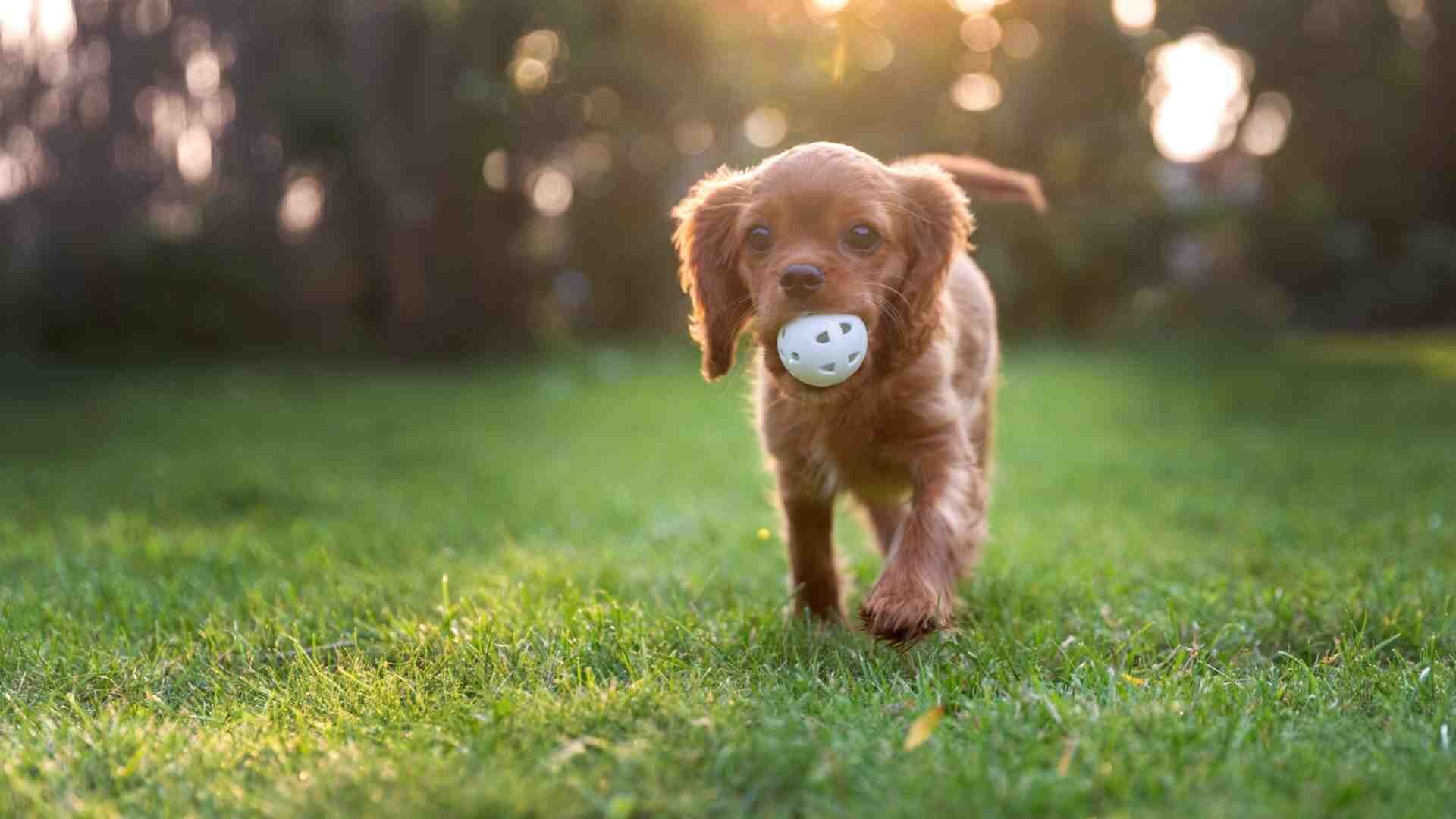If you bought a puppy at home, you might have noticed it is playful and energetic. However, you might still wonder, “how often should I play with my puppy?” Keep reading to find out more.
Your new puppy’s energy levels will be extremely high when you bring him home. He may bite at your feet and fingers, kiss you incessantly, whimper since he wants you to toss a toy, and knock at the door to get outside.
How much playtime should my new puppy have?

There is no precise science when it relates to how often play courses your new puppy requires each day. General practice is that a puppy needs five minutes of playtime every month, up to twice daily, until he is grown up.
As a result, a three-month-old puppy requires 15 minutes of activity a day, increasing to 20 minutes at four months. After they achieve maturity, which takes about a year for standard breeds and a year and up to two years for larger types, they can go out for much longer.
Your puppy’s bones are still developing, and this will persist until they achieve sexual maturity. For such a long time, the growth plates of the bones remain soft. This softness allows them to stretch out as the dog grows.
You can assure your puppy’s contentment and satisfaction in his new habitat by evaluating his leisure needs at this point. You would like to ensure your new dog is getting the attention and playing he requires at this point. He will then feel fulfilled and begin to relax a little.
How long could I play with my puppy each day?
Puppies are so adorable that we can’t stop cuddling and playing with them. Nevertheless, far too much playing may be detrimental to their health. Over-exercising your young puppy can hurt their growth and maturation, so keep vigorous activity to a minimum at first.
Your dog’s age is a significant consideration when determining how often playtime they require. Puppy exercise requirements differ with age and size. Young puppies, for instance, may demand more naps, short walks, and playfulness. They can start taking brief jogs and lengthier walking in about six months; however, too many are still not suggested.
Muscles, ligaments, and tendons all hold bones together. As a result, all of these components are still developing. These areas are prone to injury as they operate and expand to support your pup’s limbs.
Is the 5-minute rule just a myth?
One of the typical responses to the question about how long a puppy must exercise every day (including playtime) is 5 minutes for each month. This indicates that an eight-week-old dog should exercise for 40 minutes.
It’s also crucial not to break it up into different workouts throughout the day. Rather than doing one 40-minute program (which would be far too long for an eight-week-old dog), you should break it up into four 10-minute sessions.
Although this is a fantastic place to start, not all puppies are alike. Some puppies will want a lot of playtime, while others will require very little. The species, gender, and overall energy rate of the puppy must all be considered.
How to schedule a new puppy’s routine?
When you get your puppy home, there are so many unique experiences and things to consider that you may overlook one of the most critical aspects of puppy growing, starting from establishing a schedule. The best method of doing this is to make and keep to a routine. The structure will assist your new dog member of the family feel safe and understanding his responsibilities.

Below is a guide to creating a schedule providing a standard puppy routine.
1. Morning walk
Get the puppy outside for a while to relieve itself properly. After taking good care of his responsibilities, spend time with him and play with him.
2. Breakfast time
Provide breakfast to the dog. Do not allow more than fifteen minutes for the food to sit. After that, take the bowl and put it away till the next mealtime, excluding snacks used for potential training). Offer clean water in the water container.
3. Relief time
Within a few moments of eating, puppies typically need to relieve themself again, so provide another potty session. After that, spend some time with your puppy playing or conducting some instruction. Even if everyone is rushing to get up early for work or college in the mornings, take a little stroll with him to offer him another opportunity to do his duty.
4. Late morning naptime
The remaining of the morning could be spent napping, preferably in a dog kennel or pen. Even when you are home throughout the day, your puppy must spend some time in a crate or enclosure to understand how to be alone.
It’s also difficult to predict what a dog will do if you go away for a second, so there must be somewhere for him to go when you can’t oversee him immediately. If he is alone for longer than he could ever control his urine or bowels, you’ll need to put up an object with a designated spot to ease himself or hire a pet sitter.
5. Lunchtime
A repetition of the early morning routine, take a trip outside as quickly as he wakes up. Lunch should be followed by another trip out. Play with him and exercise him so he can expend some energy. Remember to take one more toilet break before your afternoon sleep.
6. Afternoon relief time
It’s time to go out after he wakes up. It’s time to start playing and exercising once more. Then it’s time to go potty. He can spend some time with you if you’re at home before supper.
7. Lunchtime
If you organize his meals around everyone, it’ll become second nature to serve him either while cooking or while the rest of the family is eating. But keep an eye on him so that you can bring him outdoors as soon as he’s done.
Giving the dog a squeaky toy to delight in his crate before the household sits down to supper is a brilliant idea. This way, he won’t get trampled, and no one will be enticed to feed him table scraps.
8. Evening relief time
Another potty break! Early evening is an excellent time for socializing. This is the “witching hour” for so many puppies, and he may calm down if you foresee it by commencing play.
Offer him a snack and let him relax in the crate for a bit if he doesn’t, even after some exercise. Later in the evening, he goes for a walk to get some exercise and to use the restroom. Also, ensure that he goes potty before bed.
9. Bedtime
Everyone benefits from a set bedtime for his transition and household training. It doesn’t matter if it’s 8 p.m. or midnight; the important thing is that it becomes a habit. Bring him to his box and assist him in getting comfortable for the night.
10. Night-time tip
Wake up early so that you can wake up, and then take your puppy out for a fast, boring potty break if he can’t yet sleep through the night. It’s advisable to get up a little earlier than you expect he will so you don’t react to his whining and howling. Then it’s back to bed to prepare for another beautiful day with your pet.
How much exercise is enough for a puppy?
Over-exercising pups, especially large-breed puppies, can induce bone and joint troubles, and two miles was probably more for even a three-month-old dog. There is no standard method for calculating your puppy’s development, but doctors, veterinarians, and instructors seem to concur that too much activity is just as dangerous as enough.
While it could be ideal if there were a chart that divided puppies by species and age and described how much activity they required each day, replete with distance and a dog fitness tracker, the situation is more complicated. Puppies and exercise are contentious topics in the dog world.
You’ll be well on your approach to a joyful, well-adjusted dog if you adopt the habit from the beginning. It’s important to put in the time and effort to ensure that bad habits and behaviors are eradicated.
How can playtime be dangerous?

Anything is dangerous, and the same can be said for playing. The repercussions from too much playing will start showing up in your dog’s long-term wellbeing, even if you don’t see it right away.
You’ll want to show your new puppy that biting you or anybody else is not acceptable when playing with him. Ensure everyone in your home understands that hands are not allowed to be used during puppy playtime.
From around the age of 14 months, the growth plates of the average puppy close. Puppies who run around and exercise too much before their bone growth close put their growth plates under much pressure.
This tension may create bone deformations, which might lead to long-term problems. This could even result in joint stiffness and bone distortion, causing them much discomfort in their later years.
Why limit playtime?
We all realize that not socializing with your dog or providing them with enough exercise is detrimental to their long-term wellbeing. However, did you know that having too much fun and exercising is just as unhealthy as not having enough?
Around the age of 14 months, a puppy’s growth plates close. Puppies who rush around it and play too often can put their growth plates under a lot of strain. This tension may create bone deformations, which might lead to long-term problems. That’s why it’s crucial to space out your workout sessions so that your dog may rest.
As your puppy matures, her activity requirements will change. Vets recommend confining exercise to short walks and frequent play periods throughout the day when your puppy is small, with enough time for naps. Older puppies will demand extra activity.
Never leave your dog exhausted after a play session. Always leave him wishing for more time to play. You’ll ultimately figure out what’s ideal for your puppy with some experience.
When do I play with my puppy?
Puppy playtimes can take place at any moment. It’s entirely up to you if they can enjoy their numerous short sessions. Once you’ve determined the best moments to interact with them, stick to the schedule, so they get acclimated to it.
Allowing your puppy to roll around on the floor might be a fun way to play with them. You can, however, improve your performance by activating both physical and mental components. Having a range of play alternatives is good since it gives your pet multiple beautiful experiences.
The optimum time for training and play is when they are full of energy. This will provide them with an outlet for their energy rather than letting it out through adverse conduct.
The sole rule here is that they cannot play or run around for an hour once they have eaten. Otherwise, it may cause stomach pain or bloat in dogs. As long as your puppy hasn’t eaten within the hour, you can play with them in short spurts.
Watch How much free time do I give my puppy | Video
How long should I spend each day playing with my puppy?
Play with your dog for a minimum of 20 minutes every day, and exercise him for 20 to 30 minutes. A bored puppy will become destructive. Playing with your puppy is also a terrific opportunity to bond with her and teach her positive social skills.
What is the best way for my dog to exercise?
Based on your dog’s age, breed, and energy level, the best approach to exercise them will vary. A senior dog, for instance, requires softer exercises than a young adult dog. In addition, a dog with reduced energy may require shorter walks than one with higher energy. Walking, swimming, abseiling, retrieving, and hiking are excellent methods to exercise your dog.
What kind of games could I play with my puppy?
It’s as simple as getting down on the ground and tumbling around with a dog. Although puppies enjoy this type of play, you may use it to help your puppy develop both muscular strength and endurance. Playtime can also instruct your dog and help him develop social skills.
What can I do to keep my bored puppy occupied?
Exercises like hiding and seeking allow you and your dog to interact while also strengthening your friendship. Boredom busters include scent games where you hide sweets or toys about the house. It’s great to provide your dog with comfort and squeaky toys, but don’t forget to include some puzzle toys in the toy box.
Is it okay for my new puppy to interact with other dogs?
It’s a great idea to let your pup play with another dog. Ensure that both puppies have received all of their vaccinations. Likewise, we want to teach the dog from a young age that the other animals are friends, not foes.
When puppies are introduced to other dogs from an early age, they are significantly less likely to be violent with other dogs as adults.
Conclusion

This article explained the common question of “how often should I play with my puppy?” The article covers many doubts and discussions regarding playing with puppies and dogs. The article refers to how much playtime or exercise your puppy requires with proper warning. The article includes a FAQ section on how often you should play with your puppy.
Stay tuned to our website to explore more interesting articles. Do not forget to look around and read our previous articles.
Bottom up
Please comment below about your ideas and share this “How Often Should I Play with My Puppy Each Day: Guide” article with your friends.
Stay tuned with our website to find out more exciting stuff. Don’t forget to check out our previous articles too.
Until the, Read about, 25 MUST Questions to Ask When Adopting a Dog: Guide





